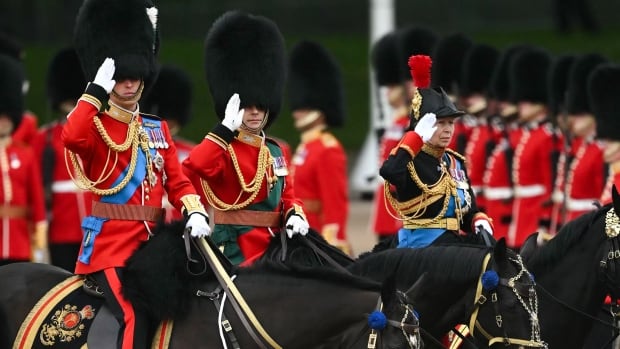While addressing a crowd at the Eurasian Women’s Forum in St. Petersburg on Wednesday, Russian President Vladimir Putin hailed government policy geared toward helping women achieve the ultimate balance — professional success while being the linchpin “of a large, large family.”
He went on to joke that Russian women can manage it easily, and still remain “beautiful, gentle and charming.”
His comments are the latest in a public push by government officials to try and reverse Russia’s sinking birth rate by appealing to a sense of patriotic duty and promising financial incentives to sway prospective parents.
Russia’s fertility rate — which measures the average number of children born to a woman over a lifetime — stands at approximately 1.4, less than what is considered the rate for population replacement, which is 2.1. Kremlin officials have labelled Russia’s statistic “catastrophic,” and it comes at a time of higher mortality among younger Russian men due to the war in Ukraine.
Earlier this month, a lawmaker told state media that just as Russia decided it needed to launch a special military operation in Ukraine, it needs a “special demographic operation” at home to ensure the country’s future.
The push to procreate
In some regions, full-time students who become new mothers will receive financial compensation, while in Moscow, the health authority is expanding free access to fertility testing and treatments.
Russia’s strategy to grow families is part of Putin’s broader push toward more traditional conservative values. In an effort to reach the younger generation, a new course is being rolled out for students in grades 5 to 9.
A course published online in August stated the goal was to instill positive attitudes toward large families. It’s part of a state narrative that encourages women to become moms for the motherland.
Some women believe its disturbing and intrusive.
“Even for women who have children and who want to have more children, [the language] is upsetting,” said Lada Shamardina, a Russian journalist for the independent medical publication Medivestnik.
Women “believe having children should be only their decision,” she said.
She continues to cover Russia’s attempts to prompt a baby boom, which in addition to incentives includes curbing access to abortions.
Low birth rate
According to data published by Rosstat, the country’s statistics agency, 599,600 children were born in Russia in the first half of 2024 — 16,000 fewer than in the same period in 2023 and the lowest since 1999.
While Russian officials have expressed alarm at the birth rate for years, in recent months lawmakers have been making sweeping, panicked proclamations about the importance of procreation.

At the beginning of September, Yevgeny Shestopalov, the minister of health for the region of Primorsky Krai, told a Russian news outlet that having a busy career wasn’t an excuse for not having a family, and that people could choose to “create offspring” during work breaks.
A few days later, Zhanna Ryabtseva, a deputy in Russia’s State Duma, said that 18- and 19-year-olds should consider having children, because “the best families are student families who then go through life together.”
To help with that, the Russian regions of Karelia and Chelyabinsk are rolling out programs where women under the age of 25 who are full-time students can receive a lump-sum payment if they become new mothers.
In Russia’s Karelia region, which borders Finland, students who have a baby can receive the equivalent of $1,500 Cdn.
In Chelyabinsk, a region in Russia’s Ural mountains, the payout is nearly $15,000 Cdn, and it can be spent on housing, education or medical services.
Access to fertility testing
Earlier this week in Moscow, women between the ages of 18 and 40 began receiving referrals for fertility testing as part of a new city-wide program.
The women were invited to take part in a test that measures the amount of anti-Mullerian hormone in their blood. The hormone, which is produced by the ovaries, reflects a woman’s ovarian reserve, or the number of healthy, immature eggs in her reproductive system.
If tests show that women have a low ovarian reserve, they will be offered follow-up treatments, including the option of freezing some of their eggs.
Shamardina believes the free testing is an excellent service for women interested in family planning. But she notes that some of the reaction on Russian social media was negative, as women started receiving unsolicited invites from Moscow health authorities for testing.

In response to an article published on the social media platform Telegram, one woman posted that the initiative made her feel like a surrogate for the state, while another compared the plan to Margaret Atwood’s novel The Handmaid’s Tale, where women are forced to produce offspring for the political elite.
“I think the main problem is that people in Russia, and most of the women in Russia, do not have trust in our government,” Shamardina said. “All of these topics are very intimate … and I think women are scared to open up this information to the government.”
CBC News spoke to one young woman living in Moscow who received an invite for the testing. She said it left her “terribly outraged.”
The woman, who connected with CBC through Shamardina, asked not to be identified because she was criticizing the state. She said the premise of the program is positive, but rolling it out unannounced to women is problematic.
“This created a feeling of coercion and invasion of personal boundaries,” she wrote to CBC through a messaging app.
“The topic of family planning is already delicate…. the media periodically calls for Russian women to give up their careers and have children, and openly condemns those who do not put family first.”
The politics of family values
While Russia’s fertility rate remains higher than many Western countries, including Canada (which stands at 1.33), Putin has said Russia’s ethnic survival depends on women having at least two children.
But he has made it clear during more than two decades in power that he would prefer to see much larger families.
The country honours families of “parental glory” who raise seven or more children. Lilia Syropyatova, 40, and her husband Maxim, 43, were given the award in 2019, and they and their nine children met with Putin in person.
“Giving birth to children is a duty,” Lilia Syropyatova told CBC News, which reached out to her through social media.
The couple, which lives in Yekaterinburg, now has 11 children between the ages of two and 20.
“Without people, there would be no state, and in order for there to be people, it is necessary to give birth to children,” Syropyatova said.

In 2022, Putin reinstated a Soviet-era honour award called Mother Heroine, which recognizes and honours women with 10 or more children.
“They think that they should return Russia to the 19th century, when it was seven children for every woman,” said Alexey Raksha, an independent Moscow-based demographer who spoke to CBC News via Zoom.
“The main propaganda and main message in the media is that women should start bearing children earlier.”
Questionable strategy
Raksha says several countries are trying to raise their fertility rate, but the actions take on a different tone in “non-democratic states” like Russia, where the government is equating a larger population with state power.
He says government will keep trying to encourage women to have more children through public messaging, but believes the campaign won’t work.
The government’s demographic quest is part of of a broader strategy of building a society on more conservative values aligned with Orthodox Christianity.
Putin — who fathered two children with his now ex-wife and is rumoured to have more with his alleged girlfriend, Alina Kabaeva, who has been sanctioned by the West — frequently frames Russian values as superior to those in Western societies. He has accused Western nations of rejecting “moral norms” and being Satanic.
Raksha says the family studies classes are an attempt to try and “brainwash” the population, and that it is “nonsense” to think it will correct the demographic trend that was predicted years ago.
He says the main driver of current low birth rate dates back to the 1990s, when there was a substantial drop in annual births in the years following the breakup of the Soviet Union.
Fewer babies then means there are fewer women of childbearing age now.







